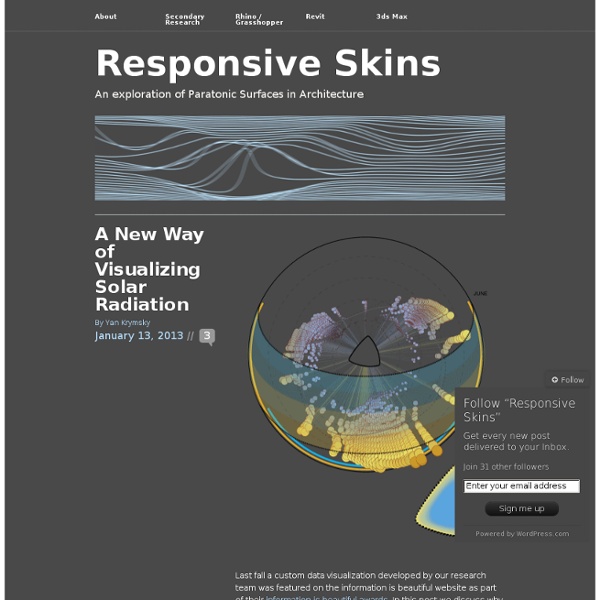



grasshopper As a way to explore the potential of Rhino Grasshopper, I started working on a series of milled panels. Each panel varies through the use of a few simple variables (grasshopper uses slider bars). These values are fed to a random number generator so the behavior is somewhat unpredictable. The surface is then contoured to approximate a milled pattern. As a variation of the simple surface, it gets slightly submerged into the stocck material, leaving a flat surface on the top with the remaining surface being milled.
Grasshopper Resources Grasshopper | Quotidien Quotidien Grasshopper Diffusion Limited Aggregation Auxin Flux CanalisationANALYSIS: Mesh Solar Incidence Slope AnalysisDISCRETIZATION: Hybrid PQROTATION: Quaternion Rotation BRep UnfoldSUBDIVISION: Medial Axis Half-Edge Mesh HEM Functions Straight SkeletonDATA IMPORT: OSM import Like this: Like Loading... Comments One Response to “Grasshopper” Trackbacks Check out what others are saying... Leave a Reply Links p55Anar+ Parametric libraryGHGrasshopper Scripting ForumRVBRhinoscript wiki Quotidien · a collection of Computational Geometry for Architecture Blog at WordPress.com. Follow Get every new post delivered to your Inbox. Powered by WordPress.com %d bloggers like this:
✐ Practice Foundry The League of Moveable Type Geometry Daily Edouard François: Édouard François Titres Chevalier des Arts et des Lettres Int. Architecte dplg Urbaniste enpc Créateur de l’Année 2011 Centre Georges Pompidou, Paris FRAC Centre, Orléans Distinctions Nommé Chevalier des Arts et des Lettres, 2012 Elu International fellow of the Royal Institute of British Architect, London, 2011 Elu Créateur de l’année, Salon Maison & Objet, 2011 Nominé pour le Brickaward, Allemagne, 2010 Equerre d’argent, nominé, 2009 Premier prix, Eco-quartier national palmarès, 2009 Premier prix, Prix de l’habitat durable, 2008 Globes de cristal, nominé, “Meilleur artiste contemporain de l’année 2006” Médaille d’argent, Académie d’architecture, fondation le Soufraché, 2002 Equerre d’argent, nominé, 2000 Mies Van der Rohe Awards, nominé, 2000 Premier prix du International Forum of Young Architect, Sofia, Bulgaria, 1997
Behind the scenes: visualizing debates on Wikipedia How consensus on wikipedia is reached? During the 2013 DensityDesign course, a group of students was analyzing the different positions on the abortion as family planning method. To identify how persons with different positions interact, part of their work focused on the italian Wikipedia page “Dibattito sull’Aborto” (Abortion Debate). Wikipedia, in fact, is a place where knowledge is built through the collaboration of several contributors that don’t necessarily share the same point of view: the results are neutral contents built with negotiation. The video below was part of the final keynote to present their project, “Unborn discussion“, and is the animated synthesis of the visual report they’ve produced. We found really effective the way our students analyzed and presented it, so we asked them to explain the design process they used both to analyse and to visualize it. Observation and confusion – First phase Img. 01 First bar chart of edits in time Img. 03 Sketches of the visualizations
Tentwelve - Agence de création de site internet Julien GRANDCLEMENT - ODBO | Directeur Artistique Freelance, Directeur de Creation, Designer | Freelance Art Director, Creative Director, Designer | IDENTITE, BRANDING, PRINT, WEB | Design Patterns Tutorials | parametric ressources OBJECTIF >Générer une surface qui « réagisse » à sa proximité avec des points ou des courbes STRATÉGIE UTILISÉE >On crée une trame de point sur une surface de référence, la distance de chacun de ces points aux objets réacteurs (pattern reactor) est évaluée (pattern reporter), puis utilisée (pattern mapping) pour générer une nouvelle altitude de ce point. La surface réactive est créée à partir de cette nouvelle famille de point. > récupérer un objet rhino dans GH > créer une trame de points sur une srf de ref > mapper des valeurs > faire réagir la définition d’un objet à la proximité d’un autre objet Dans un premier temps, il faut récupérer sur GH une surface qui servira d’emprise pour la surface réactive. Puis pour créer la trame de point, utiliser le composant Divide Surface (dans Surface/Util). La suite du modèle utilise les points que l’on vient de créer, mais dans une nouvelle organisation: nous les utiliserons « à plats », c’est à dire rassemblés dans une même liste de donnée.
parametric ressources | Ressources for Parametric Modelling in Architecture FoldaRap FoldaRap2 Release status: working In my obsession dreaming of a folding RepRap, I finally started to make one, after 5-7 months of development I'm able to travel with it around the town/country/world :) (adventures pictured on flickr / youtube / ustream) And now several people have build one : FoldaRap_Hall-of-Builds, even some by sourcing themselves the parts : google-maps (the red dots) Specifications Printed Parts: 33 Non-Printed Parts: 285 (including every bolts/nuts/washers/ferules/etc.) Special Features Foldable ! Community FoldaRap 2.5 new plates arrangement for the v2.5, to ease color associations ;) FoldaRap 2.1 after several tries and suggestions with Xav83, I ended with this simple piece that hold an endstop with a zip-tie :) (for the Z-endstop, or any machine using 20x20 extrusions) FoldaRap 1.0